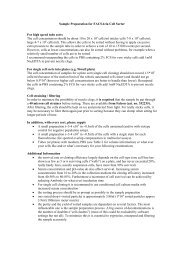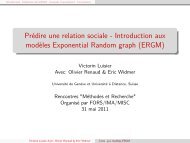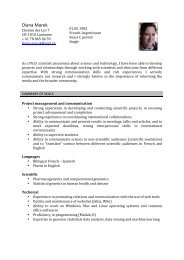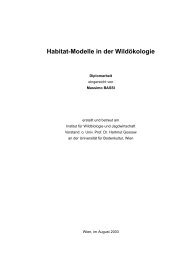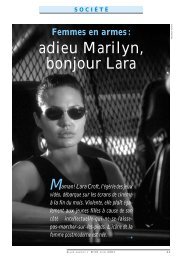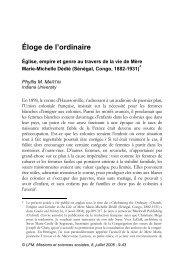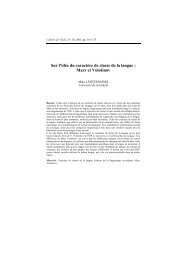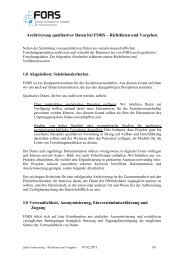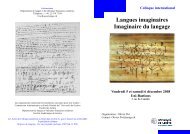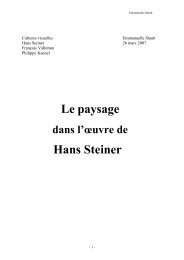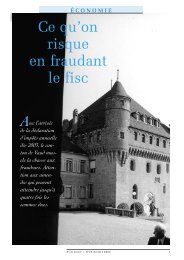162 THURSDAY 21 JULY1 Instut für Bildungsmanagement und Bildungsökonomie (IBB), Pädagogische Hochschule Zentralschweiz (,Switzerland; 2 Instut für Bildungsevaluaon, assoziiertes Instut der Universität Zürich, Switzerland; 3 Instutfür Sozial- und Prävenvmedizin der Universität Bern, Switzerland; 4 Département de Sociologie der UniversitätGenf, SwitzerlandGeneral descripon on research quesons, objecves and theorecal framework:The project ”Swiss Federal <strong>Survey</strong> of Adolescents, Main Indicators ch-x” iniates a long-term monitoring ofSwiss youth in the fields of educaon, polics, and health behaviour. The target populaon are Swiss adolescentswho are 19 years old, and it is planned that the survey will be conducted every four years in order topermit a longitudinal analysis of the Swiss youth.The theorecal framework is interdisciplinary, applying an adapted capability approach (Sen 1985; 1987; 1993;1999), which is a normave paradigm for the evaluaon of individual well-being.. In this project, the capabilityapproach is enriched with concepts of self-percepon, values, and acons in different contexts.Methods/methodology:3.42 Linking <strong>Survey</strong> and Administrave Data: A Methodological Perspecve IITo be held on July 21, 2011 from: 16:00 to 17:30, in room 321.Coordinated by:• Annelies Blom - Survex - <strong>Survey</strong> Methods Consulng, Germany• Julie Korbmacher - SHARE, MEA, University of Mannheim, Germany• Joe Sakshaug - JPSM, University of Michigan, United States• Mark Trappmann - Instute for Employment <strong>Research</strong>, Germany3.42.1 Longitudinal consent paerns and predictors of consent to linkage of survey data in the MillenniumCohort StudyS. Ketende 1 , L. Calderwood 1 , J. W McDonald 11 Centre for Longitudinal Studies, Instute of Educaon, University of London, United KingdomAt each sweep of the four sweeps of the Millennium Cohort Study (MCS), respondents have been asked forconsent to linkage of their survey data to their health, educaon or economic records. Addionally, at wave 2when cohort children were 3 years old, consent was sought from parents or guardians of the cohort children totake a sample of cohort children’s oral fluids. Tate, Calderwood and Dezateux (2006) studied predictors of consentfor data linkage for MCS sweep 1. While consent for linkage was high (92%), the proporons consenngdiffered by mother’s country of residence, age and educaon, with consent less likely among minority ethnicgroup mothers, lone parents and those with higher degrees or no qualificaons. Barngton et. al. (2009)studied the feasibility of collecng oral fluids samples in the home seng...3.42.2 Assessing the Magnitude of Administrave Non-Consent Biases in the German PASS StudyJ. Sakshaug 1 , F. Kreuter 21 JPSM, University of Michigan, United States; 2 University of Maryland, United StatesAdministrave records are increasingly being linked to survey records to enhance the survey data and increaseresearch opportunies. A usual prerequisite to performing exact record linkage is obtaining informed consentfrom respondents. Respondent consent is not universal, however, and several studies have found systemacdifferences between consenng and non-consenng cases across socio-demographic characteriscs. A naturalqueson arises as to whether the selecvity of consent introduces significant biases on key survey andadministrave esmates. Esmang non-consent biases for administrave esmates is complicated by thefact that administrave records are typically not available for the non-consenng cases. We overcome thislimitaon by ulizing data from the first wave of the German Labour Market and Social Security Study (PASS)...
THURSDAY 21 JULY 1633.42.3 Requesng Consent to Link <strong>Survey</strong> Data to Administrave RecordsJ. Pascale 11 US Census Bureau, United StatesAdministrave records have begun to play a key role in survey research and, while policies regarding consentare sll in flux, there is general agreement that research is needed on how to request consent from respondentsto link their survey data with administrave records. Previous research found that 26 percent of those iniallyopposed to data sharing shied their posion when prompted with arguments about potenal improvementsin accuracy and reducons in cost (Singer and Presser, 1996). In order to take these findings further, in thespring of 2010 a field experiment was carried out by the US Census Bureau which included three panels, eachpresenng a different raonale to the respondent for data linkage: improved accuracy, reduced costs, and reducedrespondent burden. Somewhat contrary to expectaons, there was no stascally significant differencein consent rates across the three versions of the consent queson...3.42.4 Stascal Matching of the German Ageing <strong>Survey</strong> and the Sample of Acve Pension Accounts as aSource for Analysing Life Courses and Old Age IncomesJ. Simonson 1 , L. Romeu Gordo 1 , N. Titova 11 German Centre of Gerontology, GermanyThe paper examines the combinaon of the German Ageing <strong>Survey</strong> with the Sample of Acve Pension Accountsvia stascal matching as an example for linking survey and administrave data. Stascal matching isa technique increasingly applied for combining informaon from different data sources when a record linkagebased on a unique idenfier is not possible due to confidenality restricons or aempts to avoid the arionrate linked to the informed consent requirements.3.43 Challenges in Educaonal <strong>Survey</strong>s IIITo be held on July 21, 2011 from: 16:00 to 17:30, in room 315.1.Coordinated by:• Hans Kiesl - University of Applied Sciences Regensburg, Germany• Alina Matei - Instute of Stascs, University of Neuchatel; Instute of Pedagogical <strong>Research</strong> and Documentao,Switzerland• Leyla Mohadjer - Westat, United States3.43.1 What is the appropriate me frame for measuring the frequency of educaonal acvies?S. Porter 1 , A. Ryder 11 Iowa State University, United StatesQuesons about the frequency of behaviors are common in educaonal surveys, as researchers seek to understandhow oen students engage in posive educaonal behaviors. Surprisingly lile research has beenconducted on the appropriate me frame to use, in either the educaonal literature or the broader surveymethods literature (Chang& Krosnick, 2003). This is due to the difficulty of validang the frequency quesons; generally, data externalto the survey are needed.3.43.2 Measuring the quality of teaching – A crical analysis of students’ evaluaons of teaching effec-venessS. Schief 1 , C. Young 11 University of Fribourg, Switzerland



